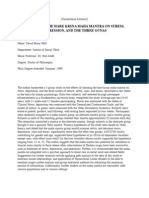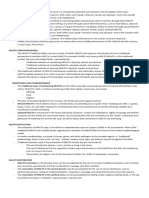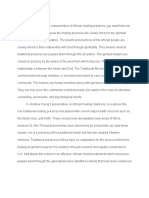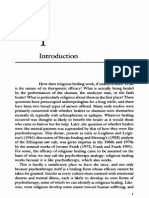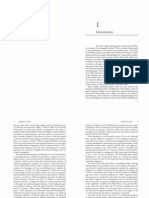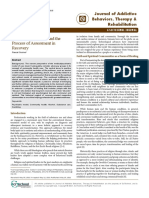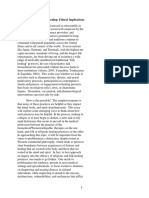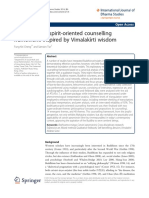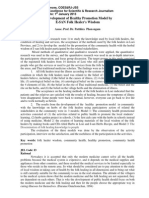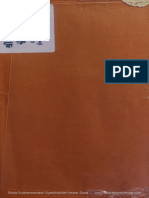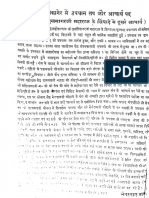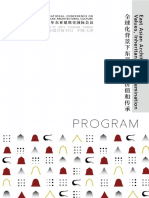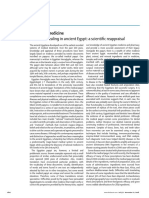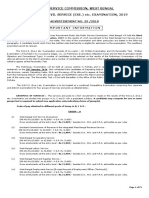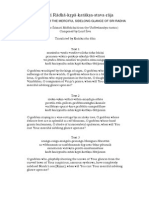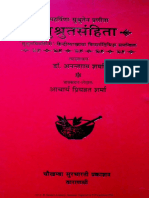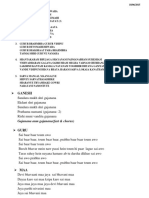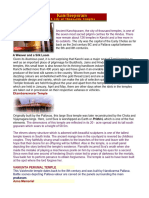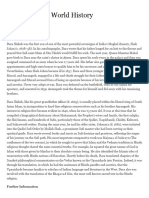Folk Wisdom and Traditional Healing Practices: Some Lessons For Modern Psychotherapies
Uploaded by
Pappoo KothariFolk Wisdom and Traditional Healing Practices: Some Lessons For Modern Psychotherapies
Uploaded by
Pappoo Kothariclick here to open the author's homepage on the internet
(To be published in Foundations of Indian Psychology, edited by M. Cornelisson, G. Misra & S. Verma, Publisher:
Pearson, New Delhi)
Folk wisdom and traditional healing practices: Some lessons for modern psychotherapies
By Ajit K Dalal
Introduction
Freedom from pain and suffering has been a major preoccupation of Indian society since
antiquity, like many other traditional cultures. Based on a shared understanding of human nature
and the causes of suffering, every society has developed its own healing institutions and
practices. The traditional systems so evolved have weathered the vagaries of time, and still thrive
in the present times on popular support. A wide range of healers and healing centres, which
includes temples, majars, shrines, local deities, etc. are found in every nook and corner of the
country. The burgeoning crowd which one sees around these places is a testimony to the fact that
their relevance for healing the human psyche has not declined. Kakar (1982) has stated in his
book, Shamans, Mystics and Doctors, that India is a country of healers. There are ṣ amans,
gurus, ojhas, tāntrics, priests, and faith healers, who specialize in dealing with a variety of social
and personal problems. The rapid progress in modern medicine has little affected the popularity
of traditional systems. According to the Fifth Plan Document (1992), India has more than half a
million traditional healers. This number, of course, includes all practitioners of alternative
medicine. A gross estimate (VHAI, 1991) suggests that more than 90% of the Indian population
use these services at some point in time. Thriving on folk wisdom and trusted by the masses,
these traditional healing practices are still an enigma for the health scientists. The main objective
of this paper is to examine these healing systems and to highlight the salience of socio-cultural
belief systems in triggering a healing mechanism within the suffering individual.
The larger scientific community and modern medicine have remained critical and
skeptical of the efficacy of these traditional practices. These are held as prescientific and
considered to be practiced by primitive and tribal people (Kothari & Mehta, 1988). It is further
argued that ignorance and backwardness are primarily responsible for adherence to these
nonscientific practices. But, as Watts (1975) contended, traditional healing practices are called
30 June 2007 — Foundations of Indian Psychology 5-4 1
primitive, mystical and esoteric because our education does not prepare us to comprehend their
sophistication. The work of Kakar (1982, 2003) and Kleinman (1980, 1988) has shown that most
of these traditional practices are deeply entrenched in folk wisdom and sound theories of mind.
These practices provide practical solutions to personal, familial and social problems, and have
been integrated in the communal life. Despite their popular mass base, there is not enough work
to test the premises of traditional practices on the scientific crucible. There is a crying need to
decipher this folk wisdom and traditional knowledge, and examine its import to augment
therapeutic services. We need to develop methodologies and mindset to learn from this rich
heritage.
Folk wisdom is a collective and accumulated knowledge base of a society which is rooted
in experience and practical considerations. Folk wisdom finds its expression in proverbs,
folklores, legends, poetry, rituals and mythologies. These sources tell us how life problems are
created, construed and controlled by the collective efforts of the community. In its struggle to
maintain harmony and order, every society attempts to develop ecologically valid understanding
of human nature; its own theories of suffering and remedial measures (Kleinman, 1988). In many
anthropological texts (e.g., Mariott, 1955) folk practices are considered to be part of the little
tradition, i.e., the beliefs and practices of the masses. Shamans, spirits, local deities are all part of
it. This is contrasted with the great tradition characterized by the practices based on classical and
philosophical texts, like Vedas, Upaniṣ ads, the Gītā. In this, God is held as the Supreme Self,
realized through contemplative meditation and devotional worship. It is a misconception that
these two traditions are parallel and that the little tradition is subscribed by lower class and caste
only. People who subscribe to the folk practices belong to all strata of the society.
In India, the folk wisdom manifested in the traditional healing practices is, indeed, based
on complex and cohesive systems of thoughts and beliefs, derived from philosophical texts and
scriptures. Not only do the folk practices derive their legitimacy from the scriptures but they also
have proven to be effective vehicles to translate the essence of scriptures into dialects that a
common man can follow. Folk beliefs and practices can be held as social representations of the
formal texts and as practical aspects of the classical theories. These are, however, contentious
issues, how folk wisdom and scriptures complement each other, and how folk wisdom got
distilled and documented in classical texts, that in turn feed into the social life. In my view, folk
and emancipatory (or scholarly) practices peacefully coexisted, though an undercurrent of mutual
30 June 2007 — Foundations of Indian Psychology 5-4 2
mistrust always remained. Of course, in the long history due to local influences, there are
distortions, diversions and mutations in folk practices on the negative side, and improvisations,
adaptations and innovations on the positive side. The folk systems have remained responsive to
local needs and expectations.
In recent years there is a resurgence of interest in understanding and acknowledging the
contributions of these traditional practices in combating physical and mental illness. Limited
success of the biomedical model and modern psychotherapies in the global scenario, and their
impersonal and market orientation has led to widespread discontentment. It is now widely
accepted that psychotherapy works in the broader cultural context, which takes into
consideration values and demands of the society (O‟Hara, 2000). With the increase in stress-
borne diseases and disorders, the spotlight is increasingly turning toward the age-old practices
and their relevance in the modern world. There is a body of literature that concurs with the
intuitive understanding and cultural sensibilities which folk healers show about the working of
the human mind and its potential to alleviate suffering. This paper explores the characteristic
features of these healing practices and will attempt to decipher the way it works. The purpose is
to draw parallels between folk practices and modern psychotherapies and identify learning
opportunities from the ancient wisdom.
Characteristic features of traditional healing practices
Sacred therapies
As mentioned by Kakar (1982), one of the distinguishing characteristics of Indian healing
practices is the role of the sacred. “The whole weight of the community‟s religion, myths and
history enters sacred therapy as the therapist proceeds to mobilize strong psychic energies inside
and outside the patient…”(p. 5). The sacred may be evoked in many forms, such as the local
versions of Lord Śivā and Hanumān, spirits of ancestors, and demons. Different healing practices
use different forms of the sacred but for most of them the physical and metaphysical worlds
overlap. Deities, demons and spirits are as much part of this physical world as they are of the
metaphysical. Folk healing endeavours to preserve harmony between these two worlds.
The sacredness of the healing practices is further reinforced by the legends associated
with the healer and/or healing centre. This author surveyed eighteen such shrines in U.P. and
30 June 2007 — Foundations of Indian Psychology 5-4 3
Rajasthan, famous for their healing prowess. Each one of these centres had a story about how
that shrine came into existence. It was either a deity who instructed a devotee in the dream, some
paranormal phenomena observed on a particular spot, miraculous recovery near some enchanted
grooves, deification of a sati, or boon bestowed on a devotee to have supernatural powers. These
legends of derived powers are recounted with reverence by the visitors, who often know these
healing stories by heart. There are rituals associated with these legends. For example, in many
temples of the mother goddess in eastern U.P. the devotees are expected to offer a fine red linen
with zari, or in the Kali temple in Chittorh, Rajastan, the patients are supposed to enter the
temple crawling. The sacredness of these places is maintained by the priests, swāmis, fakirs,
tāntrics and gurus who manage these places. It may also be mentioned here that though sacred,
many of these healing centres are secular and thronged by the believers of different faiths.
Holistic approach
Traditional healing is holistic, and aims at the overall well-being of the person. It takes body, self
and society within a framework of dynamic equilibrium. The holistic approach takes into
consideration the values, passions, beliefs, social interaction, and spiritual orientation of a person
in their healing practices.
The traditional healers often know intuitively about the close symbiotic relationship
between the mind and the body. That the body does not remain healthy when the mind is sick
and vice versa. A sick and stressed mind sets the conditions for physical ailments to inflict the
person and consequently an ailing body can be treated by changing the mental state. In the
community life, of which the healer is a part, altering the social and psychological matrix of the
suffering person‟s life is considered integral to the healing process. The healer creates
conditions in which physiological processes are connected with altered meaning and patterns of
relationships, so that one‟s social world is linked recursively to one‟s inner experiences. In the
Ayurvedic tradition, which has greatly influenced the folk tradition in India, health is a balance
among the body humours and the conditions of the external world mediated by diet and a
hierarchy of social relations organized around purity and pollution (Das, 1974).
30 June 2007 — Foundations of Indian Psychology 5-4 4
Traditional healing focuses on the person, not on the problem. In healing sessions the
attention on the problem is only peripheral; the emphasis is on „who is suffering?‟ It is the
people, not the „patients‟, who are helped to regain their normal functioning.
Thus, though some healing centres and healers specialize in the treatment of a particular
type of problems, often people with all kinds of crises frequent these places, be it physical or
mental illness, family feuds, loss in business, marital discord or wrath of spirits. At healing
centres treatment for these wide range of problems does not vary significantly. At the Balaji
temple in Ayodhya, for example, holy water is the standard treatment for all who come for
solace.
Healers as diviners
In most of the folk practices healers are mediators between the physical and the metaphysical.
One can frequently find healers who are known for their ability to host a deity or spirit and under
whose spell they acquire supernatural powers to control the minds of their visitors and to heal
them. The healer becomes the medium through which others can communicate to deities and
spirits. They get visions and can dispense away favours at will. As diviners they are presumed to
be in direct communication with the supernatural and derive their healing powers through divine
grace. They are both feared and revered by the local communities. Of course, they become
diviners only when possessed by some spirit. Otherwise they are like any other ordinary person.
These traditional healers often belong to the same clan and subscribe to the same belief
system. They are not formally educated to practice their art but learn it through apprenticeship
and assisting their gurus. Quite often they inherit their right to practice and this remains a
prerogative of a few families whose members possess special powers to heal. No matter what is
the background of the healer they need long years of internal preparation to acquire a purity of
body and mind. Most healers are not supposed to charge for their services. In fact it is widely
believed that if they charge for their services their healing powers will go away. Though the
community and patients are expected to compensate for their work, most of the healers this
author talked to also had some other sources of livelihood. They farm, rear cattle, have small
businesses or shops, teach in schools. They offer a wide range of services, and are consulted on
family and community matters. They are fortune-tellers, medicine men, clairvoyants and key
30 June 2007 — Foundations of Indian Psychology 5-4 5
informers about the community they serve. However, there seems to be a clear social hierarchy,
which determines their status, power and mode of therapeutic relationship.
Kakar (2003) holds that it is the unquestioned faith in the paranormal powers of the
healer, which is at the core of positive outcomes. It is belief in the person of the healer, not his or
her conceptual system or specific technique, which is of decisive importance in the healing
process. Kakar (1982) visited a number of shrines and healers, and observed what transpires in
the healing sessions. The suffering person often does not understand the rituals in which the
healer engages but the ambience created transports her/him into an altered state. What is of prime
importance is the trust and confidence that a healer is capable of instilling in the minds of its
clientele. The aura and authority of a healer is carefully cultivated through the stories of
miraculous healing.
The tradition of the guru as healer is not always consistent with the notion of a diviner. A
good deal of healing takes place within the guru-disciple paradigm, in which the close
relationship with the guru is an extension of the parent-child relationship (Kakar, 1991). Neki
(1975) has discussed at length the therapeutic value of the guru-chelā relationship, and of
surrender before the guru. The healing powers of the guru were observed to reside in his or her
ability to connect with the disciple‟s psyche, sending him the messages of strength and
reassurance. For people who are seeking redressal of their mundane life problems, the glimpses
of divinity in the guru is an assurance that he can deal with their problems.
Socio-centric treatment
It is implicit in all folk therapies that the illness is held as a social problem not a private affair.
Social customs, traditions, moral strictures, mode of interaction and role expectations gives rise
to pathologies which vary from culture to culture. The sociogenic nature of individual suffering
is a widely accepted fact in mental health literature. It seems logical that in the treatment of these
illnesses society ought to play a larger role. As stated by Kleinman (1988), in all Asian cultures
body-self is not a secularized private domain of the individual person, but an organic part of the
sacred, socio-centric world, a communication system involving exchange with others, including
the divine. The person in these therapies is seen as embedded in a social hierarchy and in a
30 June 2007 — Foundations of Indian Psychology 5-4 6
network of relationships. One‟s family history, which includes ancestors also, is an important
consideration in understanding the problem and deciding about the treatment modalities.
It is a general observation that traditional healing does not take place in the private
chambers of the healers, but quite often as a social activity held in an open place. People share
their problems and consult the healer in full public view. Families and other community
members also actively engage in the treatment process. Everybody knows everyone‟s problem
and it becomes a participatory venture to help out the person. This kind of ethos is ideal for the
social construction of the problem and its remedy, which has the approval and acceptance of the
community. These are the places where the personal problem is no longer seen from the ego-
centric perspective but within the larger social framework. Participation in social ritual and the
social nature of healing activities helps in relocating the person on a larger social canvas. This
shift in focus from personal to social is important for relocating the ailing person within the
social matrix.
Cultural compatibility
The healer and his/her healing practices are integral to the beliefs and practices of the local
communities. The explanatory system which a healer employs is mostly congruous with the
thinking of the masses. Evolved over centuries and verified in a countless number of cases these
beliefs about pain and suffering are compatible with the beliefs about life and the supernatural.
The theory of supernatural causation is widely believed and is frequently invoked to explain a
wide range of events. Healing practices evolved around such beliefs have thus a greater
acceptability. For example, cutting the peepal tree, which is considered sacred, amounts to
unsettling the spirits residing on it. In many parts of the country this transgression is seen as the
cause of illness or other misfortune the perpetrator is suffering from. The ojhas (holy men) are
approached to pacify the spirits so as to alleviate the suffering.
How people interpret their illness and mental state is largely determined by the society
and social relationships. Social attitudes, beliefs, norms, values, etc. provide the basis for making
sense of symptoms, etiology and import of the problem. People acquire the meaning of social
rituals, customs, communications, symbols and metaphors which help them in understanding
30 June 2007 — Foundations of Indian Psychology 5-4 7
their social world. The nature and intensity of suffering is often not contingent on the events in
the physical and social world but on their social meaning.
How do traditional therapies work?
The efficacy of folk therapies is widely acknowledged and there is mounting empirical evidence
that they work. Surveys conducted in India show that more than 90% of urban respondents
believed that the traditional therapies are effective in the treatment of physical and mental
illnesses (Purohit, 2002). However, still not much is known about how these traditional therapies
work and there is a real dearth of empirical work in India to throw light on the processes and
mechanisms underlying the healing. In this section, on the basis of available literature and
evidence, I have attempted to demystify the healing process. If we understand how these
traditional practices work, it will be possible to derive lessons for modern psychotherapy.
One factor which renders conjectures hazardous is that these folk therapies differ in terms
of their sophistication and specialization. The cultural diversity of the country has facilitated the
growth of diverse systems. It is a daunting task for any social scientist to capture the range and
diversity of these healing practices. As Kiev (1965) has noted, differentiation in the therapeutic
practices are contingent on the advancement of a particular society. In a tribal society, as among
the Bhils in south Rajasthan, the healer is medicine man, village elder and a consultant on all
important matters, beside being a holy man. They are often not high in the caste hierarchy but are
held in high esteem because of their knowledge, expertise and benevolence, and are consulted by
all strata of the community. In the arid but more developed zones of Jodhpur and Jaisalmer, the
same Bhopas specialize in treatment of bites by different species of snakes.
As discussed elsewhere (Anand, Srivastava & Dalal, 2001; Dalal, 1991; Dalal, 2000)
traditional healing practices primarily deal with psychological aspects of the problem. No matter
what are the perceived causes of the problem, be it organic, emotional or social, the suffering is
viewed as a state of mind, a subjective experience. Healers develop their own psychological
theories about the functioning of the human mind, which are implicit in their healing practices.
Kakar (1982) has concluded on the basis of an in-depth analysis of the traditional healing
systems in India that the healing powers reside primarily within the patient‟s mind rather than in
the tenets of their various faiths and ideologies. It is the tremendous outpouring and channelling
30 June 2007 — Foundations of Indian Psychology 5-4 8
of a patient‟s emotions and faith, rather than any specific aspects of the healer‟s personality or
methods, which seem to be responsible for dramatic cures. Similar observations were made by
clinical psychologists Frank and Frank (1991) about western psychotherapies as well, “The
apparent success of healing methods based on different or incompatible ideologies and methods
compels the conclusion that the healing power resides in the patient’s state of mind, not in the
validity of a particular theoretical scheme or technique”(p. 111). The equal effectiveness of
different techniques, however does not imply that they are dispensable. All healers need some
technique to trigger the healing process. In all the techniques healing is largely a by-product of
the interaction between the healer and the person, particularly the way subliminal messages are
received and interpreted.
While discussing what works in folk healing, it should be clear that not all such healing
experiences are emancipatory, nor do they all lead to elimination of the problem. Practice of
yoga and meditation may lead to liberating experience and may give insight into the ephemeral
nature of worldly problems. This is my contention that the healer has no power directly over the
disease but does have techniques to effect positive reconstrual of the disease state. Traditional
therapies focus on changing unhealthy patterns of thinking, feeling and behaving, and prepare
the person to face the vicissitudes of the problems in their social world. At times the actual
problem may not go away but as a consequence of the traditional therapy people learn to live
with it. These therapies soothe the troubled ego of the person. In other words the therapy may
result in (i) symptom relief and (ii) improved functioning. In case there is no real cure symptom
relief, may still be achieved by lowering expectations, whereas improved functioning is
contingent on remodelled pattern of social interaction, for which others in the family have to
change as well.
It is my conjecture that folk practitioners know intuitively what works in the healing
sessions. Their training and conceptual tools, however, may lead to different interpretations and
articulations of the process than what a health psychologist would construe. In this section an
attempt is made to unravel the healing process in traditional practices from a social-
psychological perspective.
30 June 2007 — Foundations of Indian Psychology 5-4 9
Subliminal healing messages
Healing takes place primarily in the transaction between the healer and the suffering individual.
Whatever be the nature of problem be, people experience emotional distress and manifest
psychological symptoms of anxiety, fear, withdrawal, dissociation, etc. These symptoms impair
their physical and mental functioning, making their suffering worse. An experienced healer
knows that these people need a reassurance. A healer creates an aura of authority over the natural
and supernatural, and reinforces the belief of a sufferer and her family that he can control the
course of events. For this it is not very important what kind of verbal exchange takes place
between the two, but how effectively the non-verbal messages are put across and received. The
healing rituals make extensive use of cultural symbolism to send the healing messages across.
The messages which are subliminally transmitted, and not mediated by the conscious mind, are
most effective in reassuring the person that things are likely to improve.
The traditional treatment of snakebites is a good case in point. In a large part of Rajasthan
Tejaji‟s name is synonymous with the treatment of snakebites. Tejaji was a commoner who was
rushing to meet his wife at her father‟s place. Inadvertently he stepped on a snake and hurt it.
The snake wanted to bite him but Tejaji pleaded that he would come back after seeing his wife
and that at that time he could bite him. The snake relented and Tejaji, as he had promised,
returned back and asked the snake to bite him. The snake changed its mind and refused to bite.
Tejaji insisted and the snake reluctantly obliged. Before Tejaji died the snake gave him a boon
that whosoever will be brought to his shrine will not die of snakebite.
Since then for the last three centuries, Tejaji‟s shrines all over Rajasthan are frequented
by the victims of snakebite. I visited one such place near Jodhpur. In my presence a person bitten
by a snake was brought in a semi-conscious state. The Bhopa (snake doctor) made strange
gestures and sounds as if invoking some spirit, recited something loudly, which I did not
understand, pressed his mouth on the open wound and sucked it. To my amazement the person
sat down after a while and after half-an hour walked back home without assistance. It was an
amazing feat and I kept puzzling what cured him. I learned much later that more than 80% of the
snakes are non-poisonous. So the traditional healer is giving psychological treatment to these
80% of the victims, who if remain unattended, show all clinical symptoms of snake biting. I
learned much later that even the most poisonous snakes only rarely inject sufficient poison for
30 June 2007 — Foundations of Indian Psychology 5-4 10
their bite to be fatal. So it might be that the fairly high but not perfect success-rate of the
traditional healers simply reflects the percentage of snakebite victims who would have recovered
in any case, perhaps increased by those cases where sufficient poison could be sucked out.
Whether this purely physical explanation is all there is to their intervention is, however, difficult
to say. How such healing might take place is not clear. One possibility is that it happens through
subliminal messages.
It is still not clearly known how such subliminal messages are exchanged. These
messages are communicated through cultural symbols, legends and myths, which arouse positive
emotions that heal. These may have powerful influence on the person, as their effect is
accentuated by an aura created by the healer. These messages are received and processed by the
unconscious mind. In an article published in the Lancet, Evans and Richardson (1988) have
shown that positive suggestions to the anaesthetized patient in the operating room lead not only
to less discomfort after surgery but also to earlier discharge from the hospital. There is much
work to suggest that subliminal messages bring change in attitudes and emotions. Cassettes and
audiotapes with subliminal messages which claim to facilitate self-healing are frequently
available in the market (Galbraith and Barton, 1990).
Broadening the domain of experience
Folk healing aims to help people to move away from too narrow and myopic a view of their
problems and to experience the larger social and metaphysical reality. The healing process
connects people with their past and future, with living and dead, with demon and divine to
broaden their range of experience. Various rituals and ceremonies solicit the indulgence of
ancestors and departed relations, who are held as part of the wider support group. People develop
a sense of belonging to a larger cross-section of people and learn to situate their problem in the
larger social matrix.
Healing thus facilitates the process of becoming a social being from an individual being
in the face of a crisis. Healing centres are places of intense social activity where people learn to
deal with the problem in newer ways. The crises experience becomes an opportunity to fully
integrate the person into the social mainstream. Imposition of social meaning on one‟s illness
and exposure to cultural symbolism brings the person face to face with others in the society and
30 June 2007 — Foundations of Indian Psychology 5-4 11
participation in the healing rituals implies that the person is accepted as an equal by those who
matter in the community. Healing occurs through broadening of the network of relationships
(Kapoor, 2003). Community healing marks the transition of a person from personal to social
identity. People develop a feeling of responsibility, competence and interdependence; and feel
reassured that they are not alone, and that their predicament is not unique.
How such broadening of experiences occurs is well illustrated in a story in Buddhist
literature. This is a story of a mother who lost her young son and was very miserable. She
approached the Buddha and implored him to relieve her of pain and agony by bringing back her
dead son. The Buddha told her that before her pain could be taken away, she would have to
perform one task. She would have to get a bowl of rice from a house where nobody had died.
The woman went from door to door throughout the village to find such a household. Several
days later she came back as a changed person. She was not able to locate any such household. In
fact, the more doors she knocked at, the more stories she heard of death and despair. Finally, she
emerged from the confines of her private suffering and realized that no one is free from
suffering. This realization mellowed her pain.
Repatterning of affective relations
All healers know from experience that emotions can be destructive and that once emotions
follow a predictable self-damaging path, suffering can become chronic. Folk healing thus
endeavours to break this pattern of emotions. Repatterning of affective relations may follow
different tracks. One is redefining one‟s relationship with self, family and social network from
very personal to role-specific, from spontaneous to functional modes of affective relationships.
Another is changing from idiosyncratic conflicts and defences to conventional conflicts and
ritualized symptoms. In doing so one develops a sense of sharing and togetherness. Often
shamans provide a kind of corrective emotional experience that leads to repatterning of defences
without what psychologists would call „curative insights‟.
Most healing encounters are of an affective nature. These encounters make people realize
their vulnerabilities and openly vent out their feelings. Siegel (1991) observed in his vast clinical
experience that when you put your feelings outside, you heal inside. Anger, anxiety, depression,
fear and many other feelings are unhealthy only if they remain buried inside, unexpressed and
30 June 2007 — Foundations of Indian Psychology 5-4 12
not dealt with. When one goes beyond one‟s surface emotions and begins to acknowledge one‟s
deeper fears, one can break through the resentments and disappointments one holds, and herein
begins the process of genuine healing. Venting out one‟s pent up emotions, particularly of deep-
rooted anger as part of the spiritual experience was found therapeutic. It helped to cleanse the
system of its negativity (Anand, 2004). In the healing process people experience new emotions, a
process that changes their way of experiencing the tragic happenings. Such repatterning of
emotions is often followed by a new pattern in social relationships as well. Change in emotions
thus leads to a more adaptive behavioural sequel, and shows the social maturity required to
handle social and moral demands.
Institutionalized catharsis
Traditional village societies in India impose many restrictions on an individual‟s conduct. The
suppression of individual desires and emphasis on role appropriate behaviour leaves little scope
for fulfilling one‟s innermost desires. The poverty, mistrust, exploitation and dehumanizing life
conditions result in accumulation of pent up emotions. Trapped in social quagmire, many women
look for some legitimate channels to vent out their pent up feelings. Traditional societies which
impose restrictions on the expression of emotions have also invented accepted ways to vent
emotions.
Maliamma's temple is a classic example of a healing institution borne out of the Indian
ethos. Located in coastal Andhra it is the temple of a local deity, called Maliamma. Maliamma
was the daughter of a poor fisherman, was married young and lived with her husband's family.
She was tortured by her in-laws who eventually threw her out of their house. Dejected and with
nowhere to go, she returned to her father who then wanted to get her remarried to an elderly
person for a paltry sum of money. Maliamma refused and did not eat anything for weeks and
eventually died. Before she died, she was presumed to have acquired some healing powers and
actually healed some people, as it is believed. So a temple was built for her in the village. Every
year on her death anniversary, only women are allowed inside the temple premise. A large
number of women from the nearby region assemble and stay there for the whole night. Possessed
by the spirit of the deity, they shout, cry, run around, get hysterical and do anything they wish.
30 June 2007 — Foundations of Indian Psychology 5-4 13
On their return a large number of them report a psychological relief (feel lighter, mentally free,
less tension), besides experiencing recovery from their chronic ailments.
That this is not an exceptional case is evident from a large number of healing centres in
the hinterlands of U.P. Here also the social ethos is no different. Because of their lower status in
the family and all the repression that goes on, a large number of women, unable to bear it any
longer, develop conversion hysteria. The woman suddenly turns violent, indecent and abusive,
and her behaviour is attributed to the spirit, which possesses her, for which she is not blamed. No
one in the family takes offence of her behaviour and during the healing sessions she is permitted
to give full vent to her feelings, which are interpreted as due to the evil spirit. Once the spirit is
driven out resulting in her recovery, everybody just laughs at what she did during her spell. The
family fearing relapse is now more considerate with her.
Creating positive imageries
The success of any healing centre lies in creating strong imageries of health, well-being and
prosperity. Through aroma, chanting, drumming and symbols an ambience is created that is
conducive to the arousal of some familiar imageries associated with strength and security. Stories
of miraculous recovery from a disease or disability are told and retold to sustain imageries of
hope and optimism. These imageries are often not of the kind found in yoga and meditation, but
relate to the mundane world and its objects. In a Śivā temple in Varanasi the devotees are made
to believe that on the full moon day the Lord Śivā will open his third eye to heat their paralysed
limbs and set them right. Many safe and effective techniques are evolved and intricately
integrated in the healing rituals to arouse cultural imageries of well-being. Such imageries are
powerful tools to bring about desired change in attitudes and expectations from healing
encounters.
That imageries bring physiological changes needs no hard evidence. The very image of a
ripe mango can wet one‟s mouth. The impact of imageries (or imagination) on physiological
processes as varied as respiration, blood pressure, heart rate, muscle tension, bowel movement,
salivation, etc. is common experience for anyone. Imageries can bring major changes in the
functioning of the autonomic nervous system. In recent times, visualization is used as a powerful
tool in the treatment of varied diseases, even cancer (Sheikh, Kunzendorf & Sheikh, 1989).
30 June 2007 — Foundations of Indian Psychology 5-4 14
Traditional healers master the art of heightening people‟s suggestibility when they induce
their particular type of imageries and healing messages. During healing sessions, the Bhopas of
Rajasthan beat the drums and everyone joins in a circular two-stepped hopping dance. The
rhythm of the drum and the steps in the dance synchronize and create a kinaesthetic experience
for both the Bhopas and their believers. This is presumed to invoke the spirit of benevolent
ancestors who can bestow health and happiness. There are many other techniques used by folk
practitioners to alter states of mind, such as chanting, slow breathing, rhythmic dancing, fasting,
sensory and social isolation, etc. This facilitates lulling of the conscious mind, rendering the
unconscious mind more receptive to the positive imageries induced by the healer. Other ways of
creating desired imageries and mindsets work by getting into a trance-like state. Healers in many
parts of the country get into an altered state of consciousness through elaborate preparation and
rituals, till they are supposed to be possessed by some divine spirit. In that state the shamans and
healers are presumed to be in direct communication with various deities, demons, spirits and
gods. They exhibit bizarre but familiar behaviour, which has symbolic meaning and transports
the audience in a world of paranormal visions and experiences. How these techniques actually
work is still an enigma to the scientific community.
Treating family and community
Most of the traditional healers know from their personal experience that treating the person is not
enough. Unless the family and the community to which the person belongs change, any
improvement in his or her mental health will be short lived. Very often the problems for which
people come to a healer have their genesis in unhealthy social relationships. It is therefore
imperative that all concerned parties participate in the healing process.
In the case of hysterical outbursts, as we observed at one healing centre, what is
gratifying for the women is that suddenly the whole family wakes up to their existence and
becomes concerned about their needs and welfare. Many women report that after their recovery
no one in the family is ill-treating them for fear of Bālājī (the monkey god). The family and other
relatives who participate in the healing rituals, many of which take place in the home setting, are
directed to bring about attitudinal change. Most of these activities are planned, keeping in view
the clientele and their specific needs.
30 June 2007 — Foundations of Indian Psychology 5-4 15
Take the example of parents of children having a major disease or disability who suffer
silently and need reassurance that the things will improve. The Avari Mātā temple in south
Rajasthan is flourishing for the last four decades as a healing centre for polio and paralysis. The
suddenness of the attack and incapacitation of the patient makes the family scared and confused.
Taking it as a wrath of the mother goddess and finding medical treatment ineffective, many of
them are rushed to this temple when struck by the disease. Situated in a hilly terrain with a quiet
river flowing along, this place is an ideal location for an outing. The patients who arrive with
family members camp here for several days. On my visit to that place, I found a party
atmosphere all around, where people sitting in small groups were chatting, or singing bhajans, or
feasting on the riverside. With so much sharing and exchange of information, their fears and
anxieties had already taken a back seat. They knew they were not alone in that tragic
predicament and that there were people who are worse of than they are. There was an air of
expectancy about the recovery; many stories of miraculous healing were already doing their
rounds. All this not only helps in overcoming the initial shock but also creates a mental state
conducive to physical recovery.
Towards developing relevant psychotherapies
The efficacy of folk healing is still a puzzle and is often doubted by health professionals,
scientists and rationalists who attribute their success to the placebo effect. At present we do not
have conceptual and methodological tools to establish a causal connection between folk healing
practices and the well-being of the targeted person. The critics of western psychotherapies and of
biomedicine have also not ruled out the placebo effect behind claims of the success of these
therapies. The placebo effect is strong evidence of the power of the mind to heal. Beecher (1955)
(1955), who has coined the term „placebo effect”, emphatically argues with supportive evidence
that about 35% of the patients improve after treatment regardless of the type of treatment. Kiev
(1965) and Frank (1961) also report similar findings. In recent times the APA Monitor
prominently featured a research study which shows that the active ingredient in the treatment of
225 depressed people was the clients‟ active participation, and the strength and duration of the
therapeutic bond between the therapist and the client (APA Monitor, Sept. 1996). O‟Hara (2000)
concludes on the basis of an extensive review that psychotherapies are effective only when they
are compatible with the value system of the society.
30 June 2007 — Foundations of Indian Psychology 5-4 16
As evidence shows, there is an element of universality among all traditional healing
practices, even though they may have evolved independent of each other. They aim at changing
the way people construe their world and modern psychotherapies also work to that end. Modern
psychotherapies are in crisis today and serious questions are raised about their efficacy in
managing mental health problems. The discontentment is evident from the fact that more than
one third of their clientele is now turning toward alternative therapies not covered by their
insurance policies. Modern psychotherapies are going through a crisis of identity and a debate is
raging about their goals, philosophy and moral vision (VandenBos, 1996). Transpersonal and
humanistic psychotherapies which had remained on the margin in the better part of the last
Century are now becoming popular. There is a renewed interest in religion and spirituality and
their role in the psychotherapeutic process (Miller and Thoresen, 2003). Traditional healing
therapies of India have much to contribute to this end. The rich know-how and techniques
employed in traditional therapies to bring about attitude change can provide new insights to
evolve more relevant psychotherapies.
Modern psychotherapies have very limited application in India. There is one
psychotherapist per half million of population. Obviously, these services are highly inadequate to
manage the massive mental health problems in India. Mutual learning from these diverse
perspectives can significantly enhance our ability to alleviate the suffering of the people. For this
we need a new conceptual framework which can integrate the finer elements of these seemingly
diverse systems. There are indeed many positive developments taking place in this direction. As
Vishwanathan (1998) writes in his article in Science, Indian society celebrates diversities and
contradictions, and has the tradition and resilience to absorb new systems and practices. There is
a real hope that a new breed of psychotherapies will emerge in India which will be useful in the
contemporary world.
References
Anand, J. (2004). Working through emotional pain: A narrative study of healing process.
Psychological Studies, 49, 185-192.
Anand, J., Srivastava, A., & Dalal, A.K. (2001). Where suffering ends and healing begins.
Psychological Studies, 46, 114-126.
30 June 2007 — Foundations of Indian Psychology 5-4 17
Beecher, H.K. (24 December 1955). The powerful placebo. Journal of the American Medical
Association, 159 (17), 18-19.
Dalal, A.K. (1991). A matter of faith. Times of India: Sunday Edition (October 11). New Delhi.
Dalal, A.K. (2000). Living with a chronic disease: Healing and psychological adjustment in
Indian society. Psychology and Developing Societies, 12 (1), 67-82.
Das, B. (1974). Fundamentals of Ayurvedic medicine. New Delhi: Bansal & Co.
Evans, C., & Richardson, P.H. (1988). Improved recovery and reduced post-operative stay after
therapeutic suggestions during general anesthesia. Lancet (August 27), 491-492.
Frank, J.D., & Frank, J.B. (1991). Persuasion and healing. London: The John Hopkins
University Press.
Frank, J.D. (1974). Psychotherapy: The restoration of morale. American Journal of Psychiatry,
131, 271-74.
Galbraith, P.L., & Barton, B.W. (1990). Subliminal relaxation: Myth or method. Weber State
University, U.S.A. Unpublished Dissertation.
Kakar, S. (1982). Shamans, mystics & doctors. Delhi: Oxford University Press.
Kakar, S. (1991). The analyst and the mystic. New Delhi: Viking.
Kakar, S. (2003). Psychoanalysis and Eastern spiritual traditions. Journal of Analytic
Psychology, 48, 659-678.
Kapoor, R.L. (2003). What is psychotherapy? Unpublished report, National Institute of
Advanced Studies, Bangalore.
Kiev, A. (1965). The study of folk psychiatry. International Journal of Psychology, 1(4), 524-
552.
Kleinman, A. (1980). Patients and healers in the contexts of culture. California: University of
California Press.
Kleinman, A. (1988). The illness narratives. USA: Basic Books.
30 June 2007 — Foundations of Indian Psychology 5-4 18
Kothari, M.L., & Mehta, L. (1988). Violence in modern medicine. In A. Nandy (Ed.), Science,
hegemony ad violence. New Delhi: Oxford University Press.
Mariott, M. (1955). Village India: Studies in the little community. Chicago: University of
Chicago Press.
Miller, W. R., & Thoresen, C. E. (2003). Spirituality, religion, and health: An emerging research
field. American Psychologist, 58, 24-35.
Neki, J.S. (1975). Psychotherapy in India: Past, present and future. American Journal of
Psychotherapy, 29, 92-100.
News (Sept. 1996). APA Monitor. Washington D.C.: American Psychological Association
O‟Hara, M. (2000). Emancipatory therapeutic practices for a new era: A work of retrieval. In
Kirk J. Schneider, James F.T. Bugantal & Jean Fraser Pierson (Eds.), Handbook of
humanistic psychology. London: Sage Publications.
Purohit, S. (2002). Faith that works. Hindustan Times (February 20). Lucknow Edition.
Siegel, B.S. (1991). Peace, love and healing. London: Arrow Books.
Planning Commission of India. (1992). Fifth Five Year Plan (1992-97). New Delhi: Government
of India.
Sheikh, A.A., Kunzendorf, R.G., & Sheikh, K.S. (1989). Healing images: From ancient wisdom
to modern science. In A.A. Sheikh, & K.S. Sheikh (Eds.), Healing east and west (pp.470-
515). N.Y.: John Wiley & Sons.
VandenBos, G.R. (Ed.). (1996). Outcome assessment of psychotherapy. American Psychologist,
51 (10),
VHAI (1991). India’s health status. New Delhi: Voluntary Health Association of India.
Vishwanathan, S. (April 3, 1998). A celebration of difference: Science and democracy in India.
Science, 280, 42-43.
Watts, A. (1975). Psychotherapy east and west. New York: Vintage Books.
30 June 2007 — Foundations of Indian Psychology 5-4 19
click here to open the author's homepage on the internet
30 June 2007 — Foundations of Indian Psychology 5-4 20
You might also like
- Folk Wisdom and Traditional Healing PracticesNo ratings yetFolk Wisdom and Traditional Healing Practices21 pages
- Traditional and Modern Psychotherapeutic PracticesNo ratings yetTraditional and Modern Psychotherapeutic Practices13 pages
- Effects of The Hare Krsna Maha Mantra On Stress, Depression, and The Three Gunas100% (2)Effects of The Hare Krsna Maha Mantra On Stress, Depression, and The Three Gunas69 pages
- Integrating Traditional Healing Practices Into Counseling and Psychotherapy, 1st Edition ISBN 0761930477, 9780761930471 FULL PDF DOCX DOWNLOADNo ratings yetIntegrating Traditional Healing Practices Into Counseling and Psychotherapy, 1st Edition ISBN 0761930477, 9780761930471 FULL PDF DOCX DOWNLOAD14 pages
- Transcultural Health Domains May 30 TuesdayNo ratings yetTranscultural Health Domains May 30 Tuesday6 pages
- Traditional Healing Practices: Opportunities For Engineering (WWW - Kiu.ac - Ug)No ratings yetTraditional Healing Practices: Opportunities For Engineering (WWW - Kiu.ac - Ug)8 pages
- Among The Healers - Stories of Spiritual and Ritual Healing - Edith L - B - Turner - Religion, Health, and Healing, Westport, Conn, Connecticut, - 9780275987299 - Anna's ArchiveNo ratings yetAmong The Healers - Stories of Spiritual and Ritual Healing - Edith L - B - Turner - Religion, Health, and Healing, Westport, Conn, Connecticut, - 9780275987299 - Anna's Archive220 pages
- Culturally Competent Care at The End of Life: A Hindu PerspectiveNo ratings yetCulturally Competent Care at The End of Life: A Hindu Perspective12 pages
- The Sacred Self - Introduction - Thomas CsordasNo ratings yetThe Sacred Self - Introduction - Thomas Csordas13 pages
- Shaman, Prophet, Sage - Deepening The Meaning of Spirituality and Social Justice For Teachers' Practice100% (1)Shaman, Prophet, Sage - Deepening The Meaning of Spirituality and Social Justice For Teachers' Practice11 pages
- Anthropology The Last Group (7) AssignmentNo ratings yetAnthropology The Last Group (7) Assignment9 pages
- Collection of Buddhist Healing Prayers and Practices100% (1)Collection of Buddhist Healing Prayers and Practices227 pages
- The Work of The Traditional Healer: Traditional Healers and Modern DoctorsNo ratings yetThe Work of The Traditional Healer: Traditional Healers and Modern Doctors2 pages
- Asklepian Dreams, The Ethos of The Wounded-Healer in The Clinical EncounterNo ratings yetAsklepian Dreams, The Ethos of The Wounded-Healer in The Clinical Encounter30 pages
- Revisiting Roots of Spirituality and Indian TraditNo ratings yetRevisiting Roots of Spirituality and Indian Tradit6 pages
- PublicationChallenges of African Traditional Healing SystemNo ratings yetPublicationChallenges of African Traditional Healing System16 pages
- Spirituality Culture and The Process of Assessment in Recovery 3s9JNo ratings yetSpirituality Culture and The Process of Assessment in Recovery 3s9J5 pages
- Oct 28 Psychology of Religious Healing Ethical ImplicationsNo ratings yetOct 28 Psychology of Religious Healing Ethical Implications19 pages
- Spirituality at The End of Life in India An Oral History ResearchNo ratings yetSpirituality at The End of Life in India An Oral History Research24 pages
- Lived Experiences of Folk Healers in SamarNo ratings yetLived Experiences of Folk Healers in Samar28 pages
- Healing Waters of Nut.1 by Kamalaliaya ShishiniNo ratings yetHealing Waters of Nut.1 by Kamalaliaya Shishini13 pages
- A Bodhisattva Spirit Oriented CounsellinNo ratings yetA Bodhisattva Spirit Oriented Counsellin52 pages
- A Development of Healthy Promotion Model 2 (1), Pp.51-60No ratings yetA Development of Healthy Promotion Model 2 (1), Pp.51-6010 pages
- Traditional Medicine Plays An Impor CompressNo ratings yetTraditional Medicine Plays An Impor Compress5 pages
- Introduction To Psychotherapy - First Lecture.No ratings yetIntroduction To Psychotherapy - First Lecture.50 pages
- Physiotherapy Advice Sheet for Deep Breathing ExercisesNo ratings yetPhysiotherapy Advice Sheet for Deep Breathing Exercises3 pages
- यज्ञोपैथी हवन से रोग निवारण वैदिक पुस्तकालयYagyopathyNo ratings yetयज्ञोपैथी हवन से रोग निवारण वैदिक पुस्तकालयYagyopathy85 pages
- Dozakhnama Conversations in Hell by Rabisankar Bal Arunava SinhaNo ratings yetDozakhnama Conversations in Hell by Rabisankar Bal Arunava Sinha280 pages
- The Saraha of Tibet How Mgur Shaped The PDF100% (2)The Saraha of Tibet How Mgur Shaped The PDF176 pages
- The Qing Ruling Legitimacy As Seen in th-1 PDFNo ratings yetThe Qing Ruling Legitimacy As Seen in th-1 PDF60 pages
- The Art of Healing in Ancient Egypt: A Scientifi C ReappraisalNo ratings yetThe Art of Healing in Ancient Egypt: A Scientifi C Reappraisal2 pages
- 216371-2 Most Free Orthopaedic Surgeries IndiaNo ratings yet216371-2 Most Free Orthopaedic Surgeries India17 pages
- Advt Scheme Syllabus WB Civil Service Exe Exam19No ratings yetAdvt Scheme Syllabus WB Civil Service Exe Exam1973 pages
- The Sixth Patriarch's Dharma Jewel Platform Sutra100% (1)The Sixth Patriarch's Dharma Jewel Platform Sutra146 pages
- CC-0. JK Sanskrit Academy, Jammmu. Digitized by S3 Foundation USANo ratings yetCC-0. JK Sanskrit Academy, Jammmu. Digitized by S3 Foundation USA652 pages
- IATA Air Transport System Course NominationsNo ratings yetIATA Air Transport System Course Nominations11 pages
- Sr. No. Register No. Name of Student Presentation TopicNo ratings yetSr. No. Register No. Name of Student Presentation Topic3 pages





